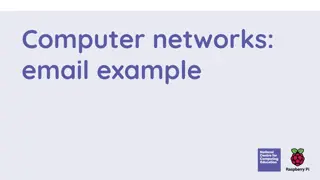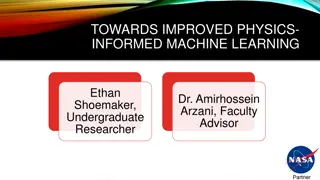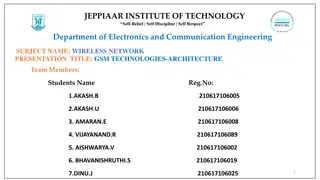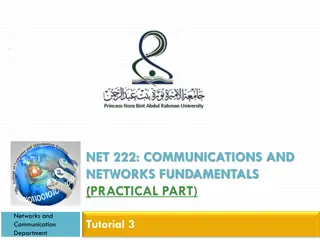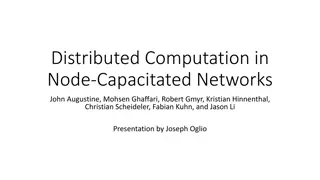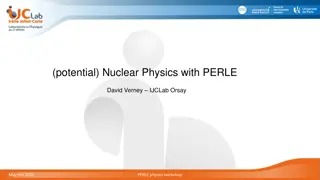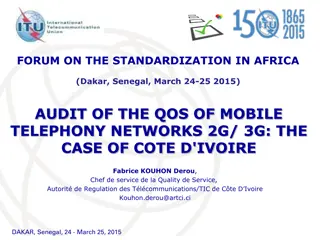Understanding Mobile Communication and Networks in Physics
Utilizing mobile phones for communication has become essential in modern society. This article delves into the technology behind mobile communication, including network infrastructure, codes associated with mobile phones, and communication protocols. Explore how mobile devices connect wirelessly and use radio waves to facilitate efficient communication across different locations.
Download Presentation

Please find below an Image/Link to download the presentation.
The content on the website is provided AS IS for your information and personal use only. It may not be sold, licensed, or shared on other websites without obtaining consent from the author. Download presentation by click this link. If you encounter any issues during the download, it is possible that the publisher has removed the file from their server.
E N D
Presentation Transcript
IDHAYA COLLEGE FOR WOMEN KUMBAKONAM 612 001 DEPARTMENT OF PHYSICS : VI : III PHYSICS : Mr. N. MAHENDRAN SEMESTER CLASS SUBJECT- INCHARGE SUBJECT NAME SUBJECT CODE TOPIC : : : COMMUNICATION PHYSICS 16SMBEPH3 UNIT - V
Mobile Amobile phone, cellular phone, cell phone, cellp hone or hand phone, sometimes shortened to simply mobile, cell or just phone, is a portable telephone that can make and receive calls over a radio frequency link while the user is moving within a telephone service area. The radio frequency link establishes a connection to the switching systems of a mobile phone operator, which provides access to the public switched telephone network (PSTN).
MOBILE COMMUNICATION: Mobile Communication is the use of technology that allows us to communicate with others in different locations without the use of any physical connection (wires or cables). Mobile communication makes our life easier, and it saves time and effort. A mobile phone (also called mobile cellular network, cell phone or hand phone) is an example of mobile communication (wireless communication). It is an electric device used for full duplex two way radio telecommunication over a cellular network of base stations known as cell site.
Mobile Network A cell site, cell tower, or cellular base station is a cellular-enabled mobile device site where antennas and electronic communications equipment are placed typically on a radio mast, tower, or other raised structure to create a cell (or adjacent cells) in a cellular network.
Codes in the Mobile Phone Mobile phones have special codes associated with them. These include. Electronic Serial Number (ESN) -Unique 32-bit number programmed in the phone. Mobile Identification Number (MIN) 10 digit number derived from the phone s number. System Identification Code (SID) unique 5 digit number that is assigned to each carrier by the FCC.
Mobile Communication Protocols: Any device that does not need to remain at one place to carry out its functions is a mobile device. laptops, smartphones and personal digital assistants are some examples of mobile devices. Due to their portable nature, mobile devices connect to networks wirelessly. Mobile devices typically use radio waves to communicate with other devices and networks. Mobile communication protocols use multiplexing to send information. Multiplexing is a method to combine multiple digital or analog signals into one signal over the data channel. This ensures optimum utilization of expensive resource and time. At the destination these signals are de-multiplexed to recover individual signal.
WIRELESS APPLICATION: Wireless application protocol (WAP) is a communications protocol that is used for wireless data access through most mobile wireless networks. WAP enhances wireless specification interoperability and facilitates instant connectivity between interactive wireless devices (such as mobile phones) and the Internet.
VSAT: Very small aperture terminal (VSAT) is a data transmission technology used for many types of data management and in high-frequency trading. VSAT can be used in place of a large physical network as it bounces the signal from satellites instead of being transported through physical means like an ethernet connection. Because the signal needs to bounce, there can be a latency issue that wouldn't exist with a physical network. However, most users feel this is the price you pay for remote access and less infrastructure, and consider it a fair trade. Weather can adversely impact the efficacy of a VSAT network.
Advantages VSAT networks have a big advantage when it comes to deployment. The ground station is communicating with satellites, there is less infrastructure required to service remote locations. This was one of the reasons Walmart chose VSAT as it started out heavily leveraged to rural America where telecommunications infrastructure was less dense than in the cities. This has made VSAT networks an ideal choice for providing connectivity to remote work sites like exploratory drilling sites that need to relay daily drill logs back to headquarters. VSAT is also independent of local telecommunications networks, making it an ideal system to back up wired systems and reduce business recovery risk. If the wired network goes down, a business can still go on using the VSAT network.
The GSM radio interface The radio interface is the between the mobile station and the fixed. It is one of the most important interfaces of the GSM system one of the main objectives of GSM is roaming. Therefore in order to obtain a complete compatibility between mobile stations and networks of different manufactures and operators the radio interface.
WiFi Wi-Fi is the name of a wireless networking technology that uses radio waves to provide wireless high-speed Internet and network connections. A common misconception is that the term Wi-Fi is short for "wireless fidelity," however this is not the case. Wi-Fi is simply a trademarked phrase that means IEEE 802.11x.
Application of Mobile and Wireless Communications Education Wireless technology is an ideal application of colleges and school. Teachers can also distribute handouts directly to students who have brought their own wireless devices to class.
All about Modems Modems used different characteristics of wave to correspond to the 0s and 1s digital data. Modems uses an RJ-11 connection to a Phone wall outlet. Half-duplex transmit in one direction only. Full-duplex transmit in both directions at Once.
Video on demand (VOD) Video on demand (VOD) is a video media distribution system that allows users to access video entertainment without a traditional video entertainment device and without the constraints of a typical static broadcasting schedule. In the 20th century, broadcasting in the form of over-the-air programming was the commonest form of media distribution.
FAX Fax (short for facsimile), sometimes called telecopying or telefax (the latter short for telefacsimile), is the telephonic transmission of scanned printed normally to a telephone number connected to a printer or other output device. The original document is scanned with a fax machine (or a telecopier), which processes the contents (text or images) as a single fixed graphic image, converting it into a bitmap, and then transmitting it through the telephone system in the form of audio-frequency tones. The receiving fax machine interprets the tones and reconstructs the image, printing a paper copy.
RADIO PAGING The Radio paging service has been defined as, Radio paging system is a non-speech, one-way personal selective calling system with alert, and also with defined message such as numeric and alphanumeric messages. ADVANTAGES: Reduces memory usage as opposed to pure paging. Share individual pages by copying page table entries.
3G-NETWORK 3G is kind of like Wi-Fi everywhere, meaning it provides Internet access via the same radio towers that provide voice service to your mobile phone. (FYI, 4G is the same thing, just faster.) Ah, but not all devices are equipped to access 3G service. The Kindle Fire and Nook Colour, for example, are Wi-Fi-only
Thank you Thank you












